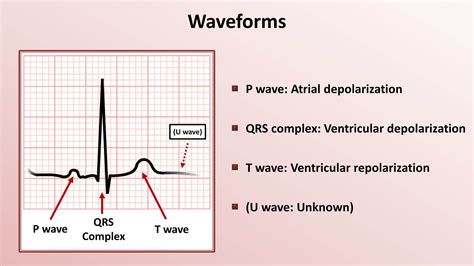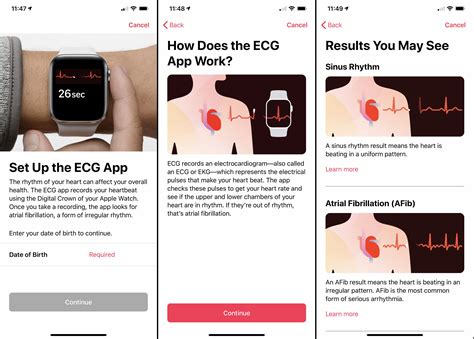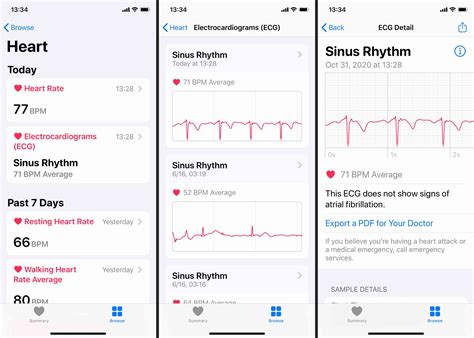Imagine having a device on your wrist that goes beyond the traditional role of a watch. No, it's not just a timepiece, it’s a personal health companion. Introducing the cutting-edge technology of the Apple Watch, which offers a remarkable feature – ECG monitoring. This feature allows you to keep a constant check on the electrical activity of your heart, providing you with valuable insights into your cardiovascular health.
By harnessing the potential of the Apple Watch, you can gain a deeper understanding of your heart's rhythm and detect irregularities that may indicate potential cardiac issues. With just a touch of your finger on the watch's built-in electrode, you can obtain a comprehensive electrocardiogram, commonly known as an ECG. The ECG is then displayed on the watch screen, effortlessly giving you real-time data about the state of your heart.
What makes this feature truly remarkable is its simplicity – the Apple Watch with ECG functionality is designed to be intuitive and accessible for every user, regardless of their medical background. The visual representation of heart activity, accompanied by easy-to-understand indicators, enables you to monitor your heart health with confidence and ease. And if any abnormalities are detected, the watch provides the option to export the ECG data for further analysis and consultation with a medical professional.
Understanding the Significance of ECG Monitoring

In today's fast-paced world, being proactive about our health has become more important than ever. One key aspect of monitoring our health is understanding the significance of electrocardiogram (ECG) monitoring. ECG monitoring plays a crucial role in identifying and assessing the electrical activity of the heart, providing valuable insights into its overall functioning.
ECG Monitoring: A Window into Heart Health
ECG monitoring allows healthcare professionals to evaluate the rhythm and electrical patterns of the heart in a non-invasive manner. By measuring the electrical impulses generated by the heart, an ECG can detect abnormalities such as irregular heartbeats, arrhythmias, and signs of ischemia or inadequate blood flow to the heart.
The Importance of Early Detection
Incorporating ECG monitoring as a regular part of healthcare not only helps in diagnosing existing heart conditions but also enables early detection and prevention. Timely monitoring and analysis of ECG data can help identify potential cardiovascular issues at their earliest stages, allowing for prompt medical intervention and a higher chance of successful treatment.
Potential Benefits of ECG Monitoring
Continuous ECG monitoring offers several potential benefits, including personalized alerts for irregular heart rhythms, improved management for patients with known heart conditions, and the ability to track changes over time. It also provides an opportunity for individuals to become more aware of their heart health and take necessary steps towards maintaining a healthy lifestyle.
The Role of Technology
With advancements in wearable technology, such as the Apple Watch, ECG monitoring has become more accessible to individuals outside of healthcare settings. The convenience of having continuous heart monitoring capabilities on the wrist allows users to keep a close eye on their heart health and share accurate data with healthcare professionals for informed decision-making.
Conclusion
Understanding the importance of ECG monitoring can empower individuals to prioritize their heart health and take proactive steps towards prevention and early detection of potential cardiac issues. Incorporating ECG monitoring into routine healthcare practices, supported by technological advancements, can significantly contribute to maintaining a healthier and more informed society.
Exploring the Basics of ECG and its Significance in Healthcare
In this section, we will delve into the foundational aspects of ECG (Electrocardiography) and examine its utmost importance in the healthcare industry. The discussion will center around the fundamental concepts and significance of ECG in diagnosing and monitoring various cardiovascular conditions.
Electrocardiography, commonly known as ECG or EKG, is a non-invasive medical procedure used to measure and record the electrical activity of the heart. It provides valuable insights into the cardiac rhythm and helps in identifying any abnormalities or irregularities within the heart's functioning. By analyzing the ECG patterns, healthcare professionals can assess the overall health of the heart and detect potential cardiac conditions.
The significance of ECG in healthcare extends beyond its diagnostic capabilities. ECG monitoring plays a crucial role in managing and treating patients with known heart conditions. It aids in tracking the effectiveness of medications, monitoring the progression of diseases, and guiding healthcare providers in making informed decisions about treatment options. Moreover, ECG data can be shared and analyzed remotely, enabling seamless collaboration between medical professionals and facilitating timely interventions.
- Understanding the ECG waveform and its components
- Interpreting ECG patterns for diagnosing cardiac conditions
- Role of ECG in monitoring and managing heart diseases
- Benefits and limitations of ECG as a diagnostic tool
- Advancements in ECG technology and its impact on healthcare
Overall, gaining a comprehensive understanding of ECG and its significance in healthcare is essential for both medical professionals and individuals looking to monitor their cardiac health. The following sections will explore the practical applications of ECG monitoring using Apple Watch, illustrating how it contributes to proactive healthcare management.
Getting Started with Apple Watch ECG Feature

Exploring the functionality of your Apple Watch and its advanced health monitoring capabilities can be a fascinating endeavor. One particularly intriguing feature worth delving into is the Apple Watch ECG (Electrocardiogram) monitoring feature. This section aims to provide an introduction to getting started with the ECG feature on your Apple Watch, allowing you to monitor your heart's electrical activity conveniently and effortlessly.
Setting Up and Activating ECG Monitoring: A Step-by-Step Guide
The following section provides a comprehensive guide on the process of setting up and activating the ECG monitoring feature on your Apple Watch. By following these step-by-step instructions, you will be able to seamlessly enable and utilize the ECG monitoring functionality, promoting your overall health and well-being.
Before proceeding with the setup, kindly ensure that your Apple Watch is fully charged and connected to your iPhone. Additionally, make sure you have the latest version of the Apple Watch software and iOS on your iPhone, as this will ensure the optimal performance of the ECG monitoring feature.
Step 1: Access the Apple Watch App To begin the setup process, open the Apple Watch app on your paired iPhone. |
Step 2: Navigate to the ECG Setting Within the Apple Watch app, locate and tap on the "Health" option. From there, select "ECG" to access the ECG settings. |
Step 3: Review Important Information Prior to activating the ECG monitoring feature, it is crucial to read and understand the important information provided. This includes details regarding the accuracy and limitations of the ECG readings. |
Step 4: Enable ECG Monitoring Once you have reviewed the information, toggle the switch to enable ECG monitoring on your Apple Watch. |
Step 5: Confirm Your Age Follow the on-screen prompts to confirm your age when prompted. You may also be required to enter your date of birth during this step. |
Step 6: Complete Calibration Process Calibration is an essential step to ensure accurate readings. Follow the instructions provided on-screen to complete the calibration process. This typically involves placing your finger on the digital crown of the Apple Watch. |
Step 7: Begin ECG Monitoring After calibration is completed, you can start utilizing the ECG monitoring feature on your Apple Watch. Simply open the ECG app on your watch, place your finger on the digital crown again, and wait for the recording to begin. |
By following these step-by-step instructions, you can successfully set up and activate ECG monitoring on your Apple Watch. It is recommended to regularly use this feature to monitor your heart health and promptly seek medical advice if any irregularities are detected.
Interpreting ECG Results on Your Apple Timepiece

Delving into the realm of monitoring your electrocardiogram (ECG) on your Apple timepiece involves not only capturing the data but also understanding how to interpret the results. While utilizing this innovative wearable technology, it is crucial to grasp the significance of the ECG readings and recognize their implications for your heart health.
Understanding the Complexity: The ECG readings on your Apple timepiece provide valuable insights into the electrical activity of your heart. These readings consist of waves and intervals that reflect the various stages of each heartbeat. By discerning the patterns and abnormalities within the ECG graph, you can gain a deeper comprehension of your heart's functioning and anomalies that may warrant further attention.
Identifying Normal Rhythms: Interpreting the ECG results means distinguishing between normal and abnormal heart rhythms. A normal ECG reading exhibits consistent patterns, with distinct P, Q, R, S, and T waves. Familiarizing yourself with these elements allows you to identify any irregularities that might be indicators of potential cardiac issues.
Spotting Potential Abnormalities: The ECG data on your Apple timepiece may also reveal abnormal heart rhythms, such as arrhythmias, atrial fibrillation, or other conditions. Detecting these irregularities entails recognizing variations in the shape, duration, or timing of the waves and intervals on the ECG graph. It is essential to consult with a healthcare professional to properly assess these abnormalities and determine possible courses of action.
Seeking Professional Guidance: While the ECG capabilities of your Apple timepiece offer convenience and monitoring on the go, it is crucial to remember that self-interpretation of the results has its limitations. It is always recommended to consult with a healthcare professional for a comprehensive analysis and guidance based on your ECG readings. They possess the expertise to accurately interpret the data and provide appropriate advice specific to your heart health.
Interpreting ECG results on your Apple timepiece not only entails understanding the complexity of the readings but also distinguishing normal rhythms from potential abnormalities. Remember to seek professional guidance for comprehensive analysis and guidance tailored to your specific heart health.
Understanding the Significance of ECG Readings for Heart Health
When it comes to maintaining a healthy heart, understanding the meaning behind ECG readings is of vital importance. ECG, or electrocardiogram, is a diagnostic tool that provides valuable insight into the electrical activity of the heart. By analyzing ECG readings, healthcare professionals can identify abnormalities or irregularities in the heart's rhythm, allowing for early detection and management of heart conditions.
An ECG reading typically consists of a series of waveforms that represent the different phases of the heart's electrical cycle. These waveforms, or ECG tracings, are commonly referred to as P, Q, R, S, and T waves. Each wave has a specific meaning and reflects a different phase of the heart's activity. By examining the shape, duration, and intervals between these waves, healthcare professionals can assess the overall health of the heart.
| Waveform | Meaning |
|---|---|
| P wave | Represents the depolarization of the atria, or the contraction of the upper chambers of the heart. |
| QRS complex | Reflects the depolarization of the ventricles, or the contraction of the lower chambers of the heart. |
| T wave | Indicates the repolarization of the ventricles, or the recovery phase of the lower chambers of the heart. |
In addition to analyzing individual waveforms, healthcare professionals also evaluate the intervals between them. For example, the PR interval represents the time it takes for the electrical impulse to travel from the atria to the ventricles. Abnormalities in these intervals can signify various heart conditions, such as atrial fibrillation or heart block.
By understanding the meaning behind ECG readings, individuals can become more proactive in monitoring and preserving their heart health. Regular ECG screenings, whether performed with an Apple Watch or at a medical facility, can provide early detection of potential heart issues, allowing for timely intervention and prevention of complications. As always, it is important to consult with a healthcare professional for a comprehensive evaluation and interpretation of ECG readings.
FAQ
How do I start using ECG monitoring on my Apple Watch?
To start using ECG monitoring on your Apple Watch, you need to first update your watch to the latest version of watchOS. Then, open the Health app on your iPhone and go to the Health Data tab. From there, tap on Heart and then ECG. Follow the on-screen instructions to set up the feature and start using it.
Can I use Apple Watch for ECG monitoring without an iPhone?
No, you cannot use Apple Watch for ECG monitoring without an iPhone. The ECG app on Apple Watch requires an iPhone to function properly as the app sends data to the Health app on your iPhone for further analysis and storage. Therefore, you need to have your iPhone paired with your Apple Watch to use ECG monitoring.
What can ECG monitoring on Apple Watch detect?
ECG monitoring on Apple Watch can detect irregular heart rhythms, known as atrial fibrillation (AFib). It can also provide insights into your heart rate, heartbeat patterns, and overall heart health. However, it is important to note that the ECG app on Apple Watch is not designed to detect heart attacks or other serious heart conditions.




